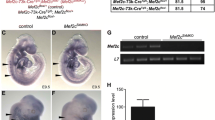Abstract
Myoglobin, an intracellular haemoprotein expressed in the heart and oxidative skeletal myofibres of vertebrates, binds molecular oxygen and may facilitate oxygen transport from erythrocytes to mitochondria, thereby maintaining cellular respiration during periods of high physiological demand1,2,3,4,5,6,7,8,9,10. Here we show, however, that mice without myoglobin, generated by gene-knockout technology, are fertile and exhibit normal exercise capacity and a normal ventilatory response to low oxygen levels (hypoxia). Heart and soleus muscles from these animals are depigmented, but function normally in standard assays of muscle performance invitro across a range of work conditions and oxygen availability. These data show that myoglobin is not required to meet the metabolic requirements of pregnancy or exercise in a terrestrial mammal, and raise new questions about oxygen transport and metabolic regulation in working muscles.



Similar content being viewed by others
References
Wittenberg, B. A. & Wittenberg, J. B. Transport of oxygen in muscle. Annu. Rev. Physiol. 51, 857–878 (1989).
Wittenberg, J. B. & Wittenberg, B. A. Mechanisms of cytoplasmic hemoglobin and myoglobin function. Annu. Rev. Biophys. Biophys. Chem. 19, 217–241 (1990).
Garry, D. J. et al. Postnatal development and plasticity of specialized muscle fiber characteristics in the hindlimb. Dev. Genet. 19, 146–156 (1996).
Parsons, W. J., Richardson, J. A., Graves, K. H., Williams, R. S. & Moreadith, R. W. Gradients of transgene expression directed by the human myoglobin promoter in the developing mouse heart. Proc. Natl Acad. Sci. USA 90, 1726–1730 (1993).
Guyton, G. P. et al. Myoglobin saturation in free-diving Weddell seals. J. Appl. Physiol. 79, 1148–1155 (1995).
Gimenez, M., Sanderson, R. J., Reiss, O. K. & Banchero, N. Effects of altitude on myoglobin and mitochondrial protein in canine skeletal muscle. Respiration 34, 171–176 (1977).
Terrados, N. Altitude training and muscular metabolism. Int. J. Sports Med. 13 (Suppl.), 206–209 (1992).
Wittenberg, J. B. Myoglobin facilitated oxygen diffusion and the role of myoglobin in oxygen entry into muscle. Physiol. Rev. 50, 559–636 (1970).
Underwood, L. E. & Williams, R. S. Pretranslational regulation of myoglobin gene expression. Am. J. Physiol. 252, C450–C453 (1987).
Doeller, J. E. & Wittenberg, B. A. Myoglobin function and energy metabolism of isolated cardiac myocytes: effect of sodium nitrite. Am. J. Physiol. 261, H53–H62 (1991).
Sidell, B. D. et al. Variable expression of myoglobin among the hemoglobinless Antarctic icefishes. Proc. Natl Acad. Sci. USA 94, 3420–3424 (1997).
Fewell, J. G. et al. Atreadmill exercise regimen for identifying cardiovascular phenotypes in transgenic mice. Am. J. Physiol. 273, H1595–H1605 (1997).
Gow, A. J. & Stamler, J. S. Reactions between nitric oxide and haemoglobin under physiological conditions. Nature 391, 169–173 (1998).
Ishibashi, S. et al. Hypercholesterolemia in low density lipoprotein receptor knockout mice and its reversal by adenovirus-mediated gene delivery. J. Clin. Invest. 92, 883–893 (1993).
Grupp, I. L., Subramaniam, A., Hewett, T., Robbins, J. & Grupp, G. Comparison of normal, hypodynamic and hyperdynamic mouse hearts using isolated work-performing heart preparations. Am. J. Physiol. 265, H1401–H1410 (1993).
Ho, C. S., Grange, R. W. & Joho, R. H. Pleiotropic effects of a disrupted K+ channel gene: reduced body weight, impaired motor skill and muscle contraction, but no seizures. Proc. Natl Acad. Sci. USA 94, 1533–1538 (1997).
Hamelmann, E. et al. Noninvasive measurement of airway responsiveness in allergic mice using barometric plethysmography. Am. J. Respir. Crit. Care Med. 156, 766–775 (1997).
Acknowledgements
We thank J. Shelton, M. Fina, C. Storey and A. Richman for technical assistance. This work was supported by grants from the NIH (to R.S.W., R.B.-D. & D.J.G.) and American Heart Association (to N.B.R.).
Author information
Authors and Affiliations
Corresponding author
Rights and permissions
About this article
Cite this article
Garry, D., Ordway, G., Lorenz, J. et al. Mice without myoglobin. Nature 395, 905–908 (1998). https://doi.org/10.1038/27681
Received:
Accepted:
Issue Date:
DOI: https://doi.org/10.1038/27681
- Springer Nature Limited
This article is cited by
-
An extra-erythrocyte role of haemoglobin body in chondrocyte hypoxia adaption
Nature (2023)
-
Generation and validation of a myoglobin knockout zebrafish model
Transgenic Research (2023)
-
Low myoglobin concentration in skeletal muscle of elite cyclists is associated with low mRNA expression levels
European Journal of Applied Physiology (2023)
-
Interneuron function and cognitive behavior are preserved upon postnatal removal of Lhx6
Scientific Reports (2022)
-
Oxygen flux from capillary to mitochondria: integration of contemporary discoveries
European Journal of Applied Physiology (2022)





